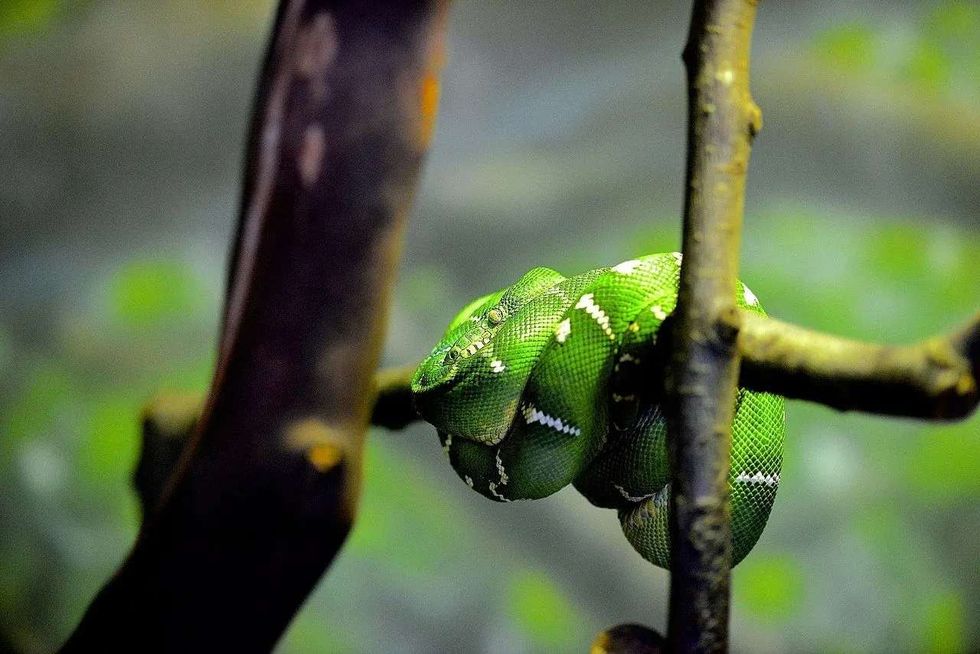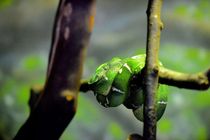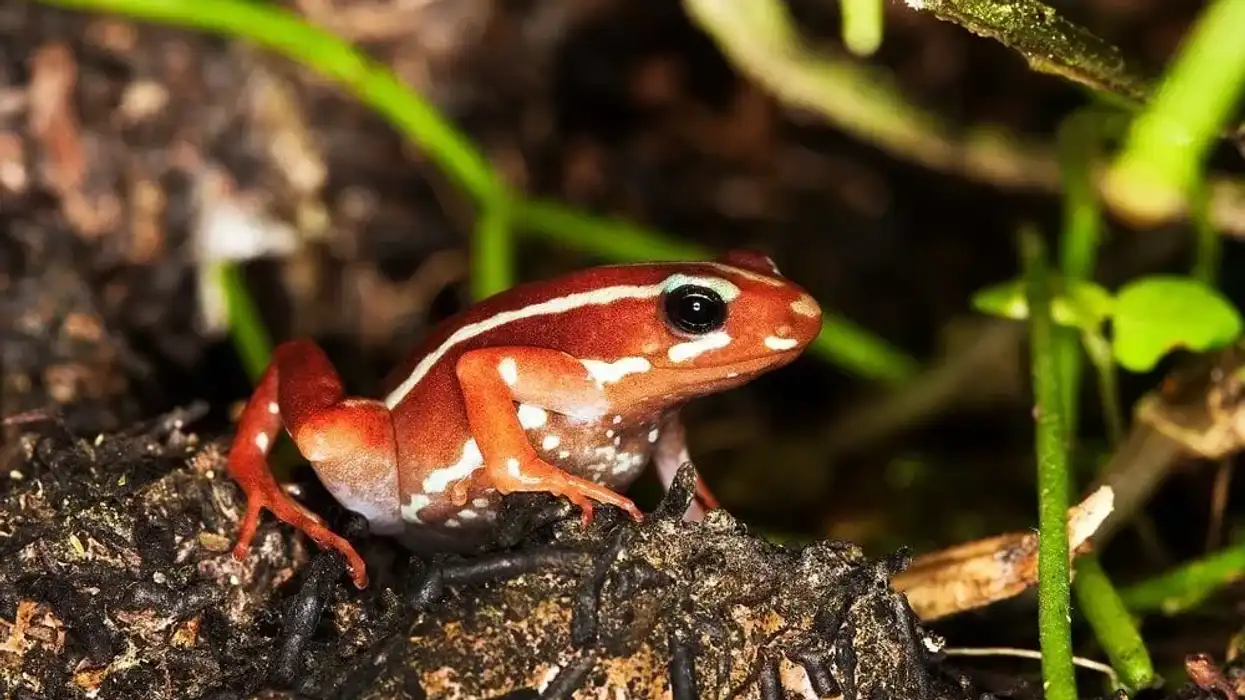The emerald tree boa is also known by its scientific name, Corallus caninus. They are non-venomous snakes, however, it's advisable to keep a safe distance from them since they have extremely long front teeth which they usually utilize to catch their prey.
They are found in tropical rainforests in South America, specifically in regions like Peru, Brazil, Colombia, Bolivia, and Venezuela. They are also present in zoos and exotic pet stores.
Their bright color and unique pattern in a white color make these emerald tree boas attractive snakes that instantly catch the eye. They are also often confused with green tree pythons.
Their color is not always emerald green, but can also be light green, dark olive green, or yellowish-green. While attacking prey, they lie on branches above the ground waiting to strike on any unsuspecting animal that appears below them.
Emerald tree boas are known as 'live-bearing snakes' because these emerald tree boas do not lay eggs like other species of snakes. Instead, they give birth to each offspring contained in its own gelatinous sack to protect it after a gestation period.
In this article, we will take a look at some emerald tree boa facts for kids as well as adults to read and enjoy. If you find this article interesting, why don't you check out our carpet python and worm snake articles as well?
Emerald Tree Boa Interesting Facts
What type of animal is an emerald tree boa?
The Amazon Basin emerald tree boa (Corallus caninus) is a type of snake present in regions of South America.
What class of animal does an emerald tree boa belong to?
The Emerald tree boa (Corallus caninus) is a type of reptile that belongs to the Boidae family. They dwell primarily in trees in the rainforest and they are solitary beings.
How many emerald tree boas are there in the world?
There are two populations of emerald tree boas, one which inhabits the Amazon Basin and the other which resides in the Guiana Shield. Scientists initially considered the two as very similar to each other but they later found differences between the two. The exact number of emerald tree boas (Corallus caninus) in the world is not known.
Where does an emerald tree boa live?
Emerald tree boa snakes live in wild lowland tropical rainforest habitats located in the Amazon Basin, northern and southern parts of America, and also in Brazil and Bolivia.
What is an emerald tree boa's habitat?
The typical emerald tree boa habitat constitutes trees. They usually hunt at night. They stay coiled up with their head in the center and catch their prey whilst hanging on the tree branch itself.
Who do emerald tree boas live with?
They are solitary beings who prefer staying alone at most times, except for mating purposes. The Corallus caninus emerald tree boa snake is also part of the pet trade and it is sadly sold illegally in many instances too.
They are quite difficult pets to care for. They need to be handled carefully and do not appreciate being thrown around or mishandled. When kept in ecological reserves and forests, they look like extremely majestic beings.
How long does an emerald tree boa live?
The average emerald tree boa lifespan is 20-30 years long. They usually live in trees in tropical rainforests, but they are also kept in reserves and as pets. Emerald tree boas are magnificent beings.
They are not easy to take care of, however, it's not impossible. Emerald tree boa predators include the crested eagle and the harpy eagle, so in order to survive, these snakes try to camouflage themselves from them. An emerald tree boa pet, however, does not need to worry about being eaten by a predator.
How do they reproduce?
Males and females only come together to mate which is usually when they turn three to four years of age. The female snake's gestation period lasts 240-260 days (which is five to seven months) and females are ovoviviparous.
During this time, there is antagonistic or fighting behavior between males and females if they are housed together since they prefer living alone in most instances.
During this time male snakes pursue female snakes and after mating, emerald tree boas do not lay eggs. Instead, females give birth to their offspring, which is unusual for this type of animal.
What is their conservation status?
The Corallus caninus emerald green tree boa snake species, native to the Amazon River, is considered as a Least Concern species by the International Union For Conservation Of Nature (IUCN).
Emerald Tree Boa Fun Facts
What do emerald tree boas look like?
The average emerald tree boa length is 4-9 ft (1.2-1.8 m). They usually sit coiled up on a tree ready to strike their predators.
Emerald tree boa teeth are long and sharp and the emerald tree boa bites their prey with the help of their teeth and fangs. Emerald tree boa fangs are sharp and long so it's essential to ensure that you keep a safe distance from these snakes even though they are non-venomous in nature.
This animal is identifiable by its emerald green body with a white pattern. The average emerald tree boa size is 2-4 lb (1.1-1.5 kg).
How cute are they?
Baby snakes are extremely cute to look at however when they are adults they are more unique in their appearance. Their color and pattern will instantly capture the eye, but they can be fairly intimidating too. Emerald tree boa handling is quite difficult when compared to other snake species.
How do they communicate?
They communicate visually and via chemical chains. They use chemicals in particular to spot their prey and they also have particular movements that they showcase when they are ready to mate. They communicate using these movements and actions in the mating season. Apart from during the mating season, they prefer to be left alone and enjoy their solitary selves.
How big is an emerald tree boa?
The emerald tree boa is 4-9 ft (1.2-1.8 m) in length which is three times bigger than rubber boa snakes who are one of the smallest species of boa in the world. Rubber boa snakes are also referred to as a dwarf boa because of their small stature.
How fast can an emerald tree boa move?
The emerald tree boa has an adequate speed when compared to other species of snakes. It adjusts its speed depending on its prey. They also have a strong grip on their teeth which also supports them in catching their prey. If you're curious about the fastest-moving snake, it's the black mamba!
How much does an emerald tree boa weigh?
Their average weight ranges between 2-4 lb (1.1-1.5 kg). Females grow larger than males and hence their weight is comparatively more than that of males who are slightly lighter in weight by two or three pounds.
What are their male and female names of the species?
Males and females are not named differently. Both male and female snakes of this species live for 20-30 years and they are differentiated by their reproductive organs and other aspects like weight and size. Female snakes of this species can weigh 3.3 lb (1500 g) while males weigh 1.7 lb (800 g).
What would you call a baby emerald tree boa?
Juvenile species range can be brown or red emerald tree boa snakes when born and they become green once they become adults. You can simply call the young of this animal a baby snake or a baby emerald tree boa.
What do they eat?
The average emerald tree boa diet in the wild consists of small mammals. These reptiles are carnivores so their diet comprises meat and they are predators of lizards, rats, squirrels, and sometimes monkeys too.
The diet of baby boas in the wild can also include small reptiles. If the emerald tree boa is kept in captivity, it can be fed a diet of mice bi-weekly.
Are they aggressive?
These snakes can be quite aggressive. Male snakes will fight among themselves. These emerald tree boas are extremely strong and their tail is prehensile which means they can grip.
Would they make a good pet?
The average emerald tree boa price is about $1500, but prices may vary depending on the region and location of the snake.
Emerald tree boa care is considered to be one of the most difficult tasks, but they are kept as pets by some dedicated owners.
Emerald tree boas bite their prey with their teeth but also use their teeth to scare others so it's good to keep a safe distance from them and carefully move them if need be in order to prevent yourself from suffering from an emerald tree boa bite.
The typical emerald tree boa temperament is fine as long they are left alone, but if they are disturbed they tend to react badly.
Also, during the mating season, they tend to get aggressive easily.
Emerald green tree boa snakes prefer cooler temperatures. They should be kept in regulated climates usually at a temperature of 75-77 F (23.8-25 C) and they should also have a spot to bask in at 85 F (29.4 C).
Apart from this, a night bulb should be used to maintain the heat within their environment after dark.
There should be a water container in any emerald tree boa enclosure as these pets use water when they shed their skin.
In captivity, the emerald tree boa is a slow-moving snake that is aggressive in nature. Whilst many snake lovers would enjoy owning them as pets, if you wish to see these magnificent beings then you could visit a zoo or a natural reserve where they are kept in captivity on display.
Did you know...
There are emerald tree boa morph varieties that are similar in appearance but different in color to the main species. These include the blue emerald tree boa, the red emerald tree boa, and the yellow and orange emerald tree boa.
The northern emerald tree boa is smaller in size when compared to the standard size of an emerald tree boa, which is thicker and long. The northern emerald tree boa also has lateral markings on its body.
The emerald tree boa has more heat sensors in its mouth than any other snake species.
As per records the most babies that a female emerald green python has ever given birth to is recorded at 25.
How to tell an emerald tree boa from a green tree python?
The green tree python is often confused with the emerald tree boa species since they are the only two snake species that sit in trees coiled up in the same manner with their heads resting in the center. However, despite this, they are not related and they are different species.
When it comes to the green tree python vs emerald tree boa, there are plenty of differences.
The former has a more rounded nose with softer edges. Another emerald tree boa vs green tree python difference is that the emerald tree boa has larger scales compared to the green tree python.
Can an emerald tree boa kill you?
There have been no recorded human deaths caused by this snake and it is non-venomous in nature. However, this snake's strength should not be taken lightly since they have the possibility to bite if they are not properly handled.
They are also not ideal pets as you might consider them to be playful and cheerful beings, but they are quite the opposite. It's essential to check whether adopting them as pets is legal in your country or not as well.
As pets, these animals need proper enclosures and adequate food and water to survive. Enclosures might need to be changed if they grow larger and longer.
Here at Kidadl, we have carefully created lots of interesting family-friendly animal facts for everyone to discover! Learn more about some other reptiles from our copperhead snake facts and cottonmouth snake facts pages.
You can even occupy yourself at home by drawing one on our free printable boa constrictor coloring pages.









